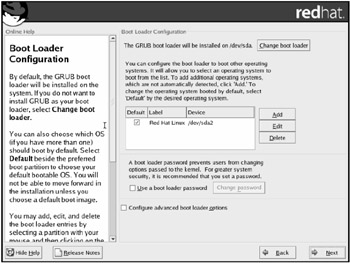2.4. Boot Loader
| | ||
| | ||
| | ||
2.4. Boot Loader
The system must know how you intend to boot it. The boot loader is configured in the Boot Loader Configuration window (Fig. 2.6). Whereas the boot loader for Windows must be installed in the Master Boot Record (MBR), a boot loader for Linux can be installed in the MBR, can be installed in the /boot partition on any other disk, or can be unused. (To select where to install the boot loader, check the Configure advanced boot loader options checkbox.) In the latter case, Linux can be booted into only from a diskette or using some other complicated method.

Figure 2.6: Configuring Linux boot loader
There exist many boot loaders for Linux. Most distributions offer the choice between Linux Loader (LILO) and Grand Unified Bootloader (GRUB). The default boot loader for Red Hat is GRUB. Unless you have some compelling reason to boot into Linux from a diskette, install the boot loader of your choice into the MBR. For this, you have to check the Configure advanced boot loader options checkbox, click the Next button, and select the appropriate choice in the dialog window that opens.
When the system is powered on, the boot loader will give you the choice of into which operating system to boot: Windows (if you have this operating system installed), Linux (or any of its kernels , if you have more than one installed), or any other system you have installed.
If you have selected not to install the boot loader into the MBR, I strongly recommend creating a bootable diskette. It may come in handy in case the Linux boot loader on the disk becomes corrupted, and it is the only way to boot the computer into Linux if you installed it without a boot loader. Depending on the Linux distribution, you will be given an opportunity to create a bootable diskette during the installation process.
- Chapter V Consumer Complaint Behavior in the Online Environment
- Chapter VIII Personalization Systems and Their Deployment as Web Site Interface Design Decisions
- Chapter IX Extrinsic Plus Intrinsic Human Factors Influencing the Web Usage
- Chapter XIV Product Catalog and Shopping Cart Effective Design
- Chapter XV Customer Trust in Online Commerce